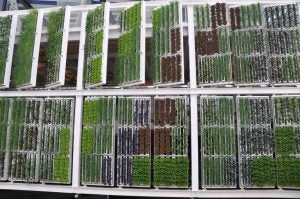As summer beckons, I hang up the academic credentials and make a pilgrimage back to the farm in New York. In this moonlighting role, my only request is to (largely) work solo — and my family happily obliges. Consider it recuperation for an accidental extrovert.
During this siesta with me, myself, and I, I’m unusually pensive about the global state of agriculture. Far removed from the homestead in rural Virginia, I see firsthand how far removed the “city folk” are from the daily grind.
But vertical farming is poised to be the great equalizer — in theory. No doubt we’ve all heard about efforts to grow agriculture’s social footprint: reclaimed city lots, factories repurposed to grow hydroponic crops, barges retrofitted with greenhouses, and green roofs. We’ve slowly acculturated ourselves to the idea of ag in nontraditional settings.
But these are trivial compared to the hype of vertical farming. Situated on the outskirts of every major metropolis, a literal crop high rise would produce a bountiful yield at a much greater volume per unit area than traditional row cropping. With the bulk of the human population expected to reside in cities, production centers would logically be tied to markets. Water and nutrient use would be significantly more efficient. And the system would be entirely closed, deftly recycling resources and preventing environmental loading. The icing on the cake is a locally installed green energy system with solar panels and/or wind turbines, powering this modern day marvel. And it has social justice undertones — it’ll democratize food access for underserved populations! The unofficial tagline might be “Premium quality at bargain basement prices.” It’s a nifty proposition on paper.
So is traditional “dirt” farming a relic? Hardly. Vertical farming has been oversold, expert level.
It’s like one of those ill-conceived products that you can’t fathom anyone bankrolling. Yet someone in an executive boardroom made an impassioned plea and convinced (conned?) investors to open up their wallets. I seriously wonder if anyone has run a realistic cost-benefit analysis and formulated a business plan. Like any concept, it needs to be run through the common sense ringer a few times.
First off, real estate in metro areas is cost prohibitive. While transportation and distribution costs would be nominal — and it would certainly meet the most stringent 50 mile radius of “locally grown” — land costs are a first-order sticker shock. Then there’s the construction costs of the automated facility itself — not to mention the garish monstrosity of a design from artist’s renditions I’ve seen. Moreover, year-round production is a demanding mistress. What sort of energy inputs (even with a partially green portfolio) would it take to maintain a facility at 68+ degrees year round, despite seasonal extremes outside?
It also seems to perpetuate this “factory farming” model (whatever that is) that we hear nothing but scorn about. Is this corporate behemoth going to throw smaller producers — like my fifth-generation family farm — under the bus on sheer volume?

Other questions are more nuanced. Does a vertical farm really shore up this urban disconnect? Perhaps knowing where food comes from. But what about the who, what, and why? We need to resolve a more complete picture and humanize the faces behind agriculture. Does a soulless automated system accomplish this? Although a network of community gardens would produce a fraction of the yield — wouldn’t getting one’s hands dirty do more to cultivate an ethic of empathy? Certainly a less measureable quantity than yield, but still important. Grassroots for sure.
That’s not to say that vertical farming doesn’t make an effort to intersect with some genuine issues. Food deserts for one. But will this be resolved overnight by simply changing the vendor and transplanting them close to markets?
In the immortal words of Marlon Brando, “I coulda’ been a contender.” Well, not really. Far from a wunderkind, we’ll look back on this flirtation with vertical farms as a truly cockamamie idea. There are far more fruitful ways to make a dent in our march toward food security and ag outreach.
Tim Durham’s family operates Deer Run Farm — a truck (vegetable) farm on Long Island, New York. As an agvocate, he counters heated rhetoric with sensible facts. Tim has a degree in plant medicine and is an Assistant Professor at Ferrum College in Virginia.



